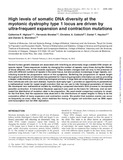Mostrar el registro sencillo del ítem
High levels of somatic DNA diversity at the myotonic dystrophy type 1 locus are driven by ultra-frequent expansion and contraction mutations
| dc.creator | Higham, Catherine | |
| dc.creator | Morales Montero, Fernando | |
| dc.creator | Cobbold, Christina | |
| dc.creator | Haydon, Daniel | |
| dc.creator | Monckton, Darren G. | |
| dc.date.accessioned | 2013-11-22T20:48:09Z | |
| dc.date.available | 2013-11-22T20:48:09Z | |
| dc.date.issued | 2012-02-24 | |
| dc.identifier.issn | 0964-6906 | |
| dc.identifier.other | essn:1460-2083 | |
| dc.identifier.uri | https://hdl.handle.net/10669/8921 | |
| dc.description | artículo científico (arbitrado)--Universidad de Costa Rica. Instituto de Investigaciones en salud y Escuela de Medicina, 2012. Este artículo es privado debido a limitaciones de derechos de autor. | es |
| dc.description.abstract | Several human genetic diseases are associated with inheriting an abnormally large unstable DNA simple sequence repeat. These sequences mutate, by changing the number of repeats, many times during the lifetime of those affected, with a bias towards expansion. These somatic changes lead not only to the presence of cells with different numbers of repeats in the same tissue, but also produce increasingly longer repeats, contributing towards the progressive nature of the symptoms. Modelling the progression of repeat length throughout the lifetime of individuals has potential for improving prognostic information as well as providing a deeper understanding of the underlying biological process. A large data set comprising blood DNA samples from individuals with one such disease, myotonic dystrophy type 1, provides an opportunity to parameterize a mathematical model for repeat length evolution that we can use to infer biological parameters of interest. We developed new mathematical models by modifying a proposed stochastic birth process to incorporate possible contraction. A hierarchical Bayesian approach was used as the basis for inference, and we estimated the distribution of mutation rates in the population. We used model comparison analysis to reveal, for the first time, that the expansion bias observed in the distributions of repeat lengths is likely to be the cumulative effect of many expansion and contraction events. We predict that mutation events can occur as frequently as every other day, which matches the timing of regular cell activities such as DNA repair and transcription but not DNA replication. | es |
| dc.description.sponsorship | Universidad de Costa Rica. | es |
| dc.language.iso | en_US | es |
| dc.publisher | Human Molecular Genetics, 2012, Vol. 21, No. 11 2450–2463 | es |
| dc.rights | CC0 1.0 Universal | * |
| dc.rights.uri | http://creativecommons.org/publicdomain/zero/1.0/ | * |
| dc.subject | Mutación | es |
| dc.subject | Genética | es |
| dc.subject | ADN | es |
| dc.subject | Epistasis genética | es |
| dc.title | High levels of somatic DNA diversity at the myotonic dystrophy type 1 locus are driven by ultra-frequent expansion and contraction mutations | es |
| dc.type | artículo original | |
| dc.identifier.doi | 10.1093/hmg/dds059 | |
| dc.description.procedence | UCR::Vicerrectoría de Investigación::Unidades de Investigación::Ciencias de la Salud::Instituto de Investigaciones en Salud (INISA) | es |



